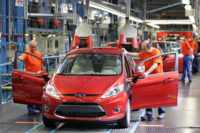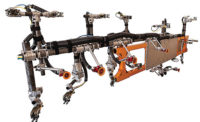Green manufacturing not only benefits the environment by minimizing natural resource use. It also benefits the manufacturers. Ford Motor Co. knows this, and has replaced many of its traditional high-intensity discharge and fluorescent lights with LED fixtures to lower its energy use by 25 percent per vehicle produced.
“Moving to LED gives us impressive efficiency improvement,” says George Andraos, director of energy and sustainability at Ford Land, a subsidiary of Ford Motor Co. and a full-service provider of real estate, construction and facility services. “We worked closely with its scientists and suppliers to investigate and follow the rapid development of LED lighting. In 2013, we selected Dialight Corp., a leading LED industrial fixture manufacturer, to develop light fixtures that meet [our] global needs.”
Ford installed the first LED fixtures in August 2014 at its truck plant in Dearborn, MI, where the latest version of the F-150 is assembled. Over the next 16 months, workers installed LEDs at 17 other Ford manufacturing facilities worldwide. These include the company’s truck plant in Louisville, KY; transmission plant in Livonia, MI; stamping plant in Dearborn; engine plant in Windsor, Ontario; engine plant in Dagenham, England; and SUV plant in Oakville, Ontario.
Overall, a total of 25,000 LED fixtures were installed, enabling Ford to reduce its energy use by hundreds of million kilowatt-hours annually. Andraos says this amount represents up to a 70 percent reduction in lighting energy consumption, and a yearly savings of about $7 million.
He added that the switch to LED lighting cost $25 million, but has helped Ford meet its energy conservation target. Equally important, the LED lights improve worker safety by eliminating hazardous materials in fixtures and lowering fire risks. The lighting also provides a brighter work area, better uniformity and improved color perception by employees.
Another automotive manufacturer benefitting from Dialight LED lighting is Martisa, which produces metal parts at its large Barcelona plant.
Several years ago, the facility’s 32 400-watt high-pressure sodium (HPS) lights often flickered and dimmed due to energy surges caused by the plant’s metal processing machinery.
The HPS lights produced inconsistent lighting throughout the plant, and also took 10 minutes to re-strike following power outages, negatively impacting productivity. Maintenance was also a challenge, as the HPS lights were mounted at a height of 9 meters, ran 10 hours a day five days a week, and had to be replaced every 10,000 hours.
This led company executives to meet with energy consultant Area Energetica and learn about Dialight’s DuroSite LED High Bay lights. These 150-watt lights are L7 rated to last 80,000 hours and maintain 80 percent luminance after 60,000 hours. They produce minimal heat with no ultraviolet light or infrared radiation, and require no maintenance.
Martisa workers mount DuroSite lights at the same height as the HPS lights, but the former provide consistent luminescence of 200 lux at floor level. The lights also switch on and off instantly to improve lighting efficiency and reduce re-strike time following power outages.
Martisa’s lighting energy usage has dropped by 69 percent, from 9.9 watts per square meter to 3.7 watts. The plant’s carbon emissions have been reduced as well.
Each fixture weighs 17 pounds and features a housing made of copper-free, powder-coated aluminum. IP6-rated, the housing is designed to withstand dust and moisture. The fixture can be equipped with an acrylic, polycarbonate or tempered flat lens, or a polycarbonate dome lens.
For more information on LED lights, call 732-919-3119 or visit www.dialight.com.





